Three years ago I found myself playing music in front of an audience for the first time in more than 20 years. This is what I wrote about the experience.
It had finally become one of those “put your money where your mouth is” moments. For years I was asked if I would bring my bass to church and play in the ensemble that provides music before and after the service, and sometimes accompanies the choir on a couple of hymns. I had repeatedly begged off, citing as reasons everything from being too busy to practice to being too rusty to play. Two Sundays ago, when I was out to lunch with the friend who is the arranger and leader of the ensemble, he asked me again. This time, for whatever reason, I wavered.
It would seem that of all the people who might step up and contribute musically if he had the ability to do so, one who writes a weekly column on the importance of the arts—not to mention constantly harangues his fellow citizens to get involved artistically in the community—should certainly do it himself. Either that or quit pestering everyone.
So I agreed and last Sunday played the bass in front of an audience for the first time in twenty years. Yes, the fingers were a little rusty, but by the end of the service I felt like I knew what I was doing. Despite the worst-case scenarios I’d imagined, none of the songs on which I played came to a crashing stop, and I kept the out-of-key notes to what to me (if not to my fellow musicians) seemed like a minimum. We’ll see next Sunday if any visitors that happened to be there last week resolved not to return because of errant bass lines.
And now I can deliver my encouragement to people to get involved in the arts without feeling like I’m not practicing what I’m preaching.
Years ago, I played in a band in Austin, making enough to pay the bills and that sort of thing. We performed regularly around town and even went on the road to Dallas, Houston, Laredo, Lubbock, and as far afield as Steamboat Springs, Colorado. Although we were playing most of our gigs in Austin, known around the country as the “live music capital of Texas,” at no point did I consciously consider myself part of any civic element. My guess is that amateur or semi-professional artists of all kinds don’t automatically think that way.
But they are. I was in Studio Gallery last week and saw paintings by two people I know. There were several pieces by Richard Skurla, a talented professional artist whose work I admire and whom I’ve known in passing almost as long as I’ve lived in Waco. There was also a striking portrait of Willie Nelson painted by a friend I know from church named Bill Austin. I had seen it in a show at Art Center Waco a year or so ago, and now it was up at Studio Gallery. I don’t know off-hand if Bill, an amateur artist, thinks of himself as part of the Waco art scene, but he clearly is as well.
Unless it’s a place like East Hampton or Santa Fe, which for years were dominated by a few huge-name painters who lived and worked in those areas, a local art scene is made up of what George Bush once called “a thousand points of light.” Artistic talent is by no means limited to a few professionals. It’s spread around far and wide. And one of the keys to a healthy arts scene is for people to get involved artistically in any way they can, and then pay closer attention to the larger arts scene of which they’re now a part.
A version of this column originally appeared on September 4, 2014 in the Waco Tribune-Herald.

